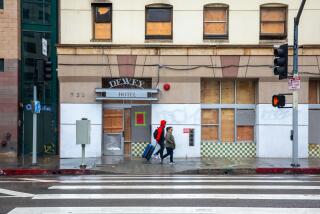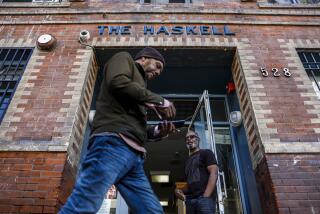Mission hopes a fee will change skid row’s culture
I was five minutes into my skid row ride-along when I wound up alone in an idling police van, watching LAPD Officer Deon Joseph handcuff a drunk for raising a ruckus inside the Union Rescue Mission.
We had barely gotten rolling again when the security guard at a residential hotel across the street flagged him down. A tenant, recently paroled, was accused of stealing his neighbor’s welfare benefits card. I went inside with Joseph this time. A few minutes later, I saw a speeding patrol car whiz by outside. The robbery suspect was about to drop back one space in line.
Because down the block, at the spot we’d just passed, a line of police officers had cordoned off a stretch of road and were trying to keep the peace in a growing crowd. A street fight between two skid row denizens — one upset because his mail hadn’t arrived — had led to a police chase, a brief tussle, a spray of rubber bullets. Now there was a standoff between a couple dozen cops and twice as many hecklers, many with cellphone cameras and YouTube ambitions.
I’d seen enough in one hour to understand what police in skid row are up against. Neither good intentions nor an iron fist are a match for the stew of addictions, mental illness and criminal intent that keeps bubbling up in this no-man’s land.
Officer Joseph got in touch with me because of a column I wrote last fall about a philanthropist’s offer to donate rolling shelters to people sleeping in cardboard boxes on sidewalks. Joseph thought it was a terrible idea; that the tent-like contraptions would be commandeered by thugs, gang bangers, pimps and drug dealers.
That’s exactly what’s happened since then, he said. A dozen of the shelters were handed out in November — most to women and disabled men — and all but a few have disappeared. There were five lined up against a wall last Thursday, across the street from the mission’s exit on a crowded stretch of San Julian Street.
Joseph walked me to them, unzipped the tarps, pulled the tents clear of the grimy wall. I saw a stash of empty beer cans, a used condom, ripped plastic bags used to package cocaine, glass remnants of a shattered crack pipe — signs of drug-dealing and prostitution. I also saw sneakers, jackets, a neatly folded blanket — the basics of a sidewalk home.
“I want these moved, off the sidewalk,” Joseph bellowed. “Off this block!”
A slim man with an earring and neatly trimmed mustache rolled over on his bicycle and said, just as loudly, that he wasn’t going. Tony Lavan told me that he’s tired of being pushed around. “The last time he told us to move them and we didn’t, he got his [patrol] car and pushed them down the block.
“This is our street,” Lavan told me, his voice getting louder. Police already roust them when they sit on the sidewalks, he pointed out. “What are we supposed to do? Where do they want us to go?” he asked. “We live here!”
The rolling tents, like so much else on skid row, are a symbol whose meaning shifts depending on where you sit — or where you can’t.
*
Los Angeles is four years into its Safer City Initiative, which added 50 police officers to skid row with a mandate to make arrests for minor infractions. Last year, it was beefed up with civil injunctions banning drug dealers and gang members who come to skid row to peddle drugs and run loan-sharking rings.
Joseph tells me Safer City is working; the area is calmer, cleaner and less crowded than when he began on the beat 13 years ago. But it wouldn’t take much to tip the balance. Gang members and parolees are moving off the streets and into the area’s hotels and missions, he said, fueling concerns that their crimes will be harder to stop.
At the Union Rescue Mission, director Andy Bales has beefed up security and is changing residence requirements, in part to deal with those concerns. Beginning next month, “we will no longer simply have guest beds with no expectations,” he said. Most residents will be required to pay for a bunk: $7 a night, with $2 of that kept for the guest in a savings account.
Almost everyone who hangs around skid row has some kind of income, Bales said. Some get $600 or more in monthly Social Security payments, others about $210 a month from the county’s general relief program. “Most of them fritter away their money in some fashion,” he said. Between the lines, I hear alcohol and drugs.
Under the new plan, “they will agree to be sober and pay part of their way,” he said. The money will help hire case managers to counsel them and connect them with help. And the guests will get a footlocker in which to store their belongings and a chance to stick around during the day, to take classes or grab a nap.
The income will be just a drop in the bucket for the mission financially. It costs about $25 per bunk to run the program, which has been hit during the recession by multiple demons: a drop in contributions, forced pay cuts and furloughs for mission staff. An increase in clients needing help means the chapel and hallways are crowded with cots.
But Bales said that pay-to-stay is more about changing the culture of the place than filling the mission’s coffers. “Residents are tired of the shelter scene,” he said. “They want a place where they can grow … and move on. Escape homelessness, not get comfortable here.”
What’s the shelter scene? “Three hots and a cot,” Bales said. You come to eat, you leave, you come back to sleep. It’s a routine that encourages idleness and does little to stabilize those looking to change.
The change sounds like a good idea to me. But it got mixed reviews on the street. “Who’s got that kind of money?” asked Lavan, still fuming about the prospect of losing his tent.
But Deborah Lynn Bunch said it might be the kind of kick in the pants that some folks need. She spent 11 years on skid row and two in prison. When she needed a hand, Officer Joseph helped her get into permanent housing, she said. She lives on South Los Angeles Street now, “sober and bored.” She was on skid row Thursday to visit friends.
There are people spending more than $7 a night to feed their addictions. “Give them something else to do with that money and they just might change,” she said. Then she bade her friends goodbye and headed home.
More to Read
Start your day right
Sign up for Essential California for news, features and recommendations from the L.A. Times and beyond in your inbox six days a week.
You may occasionally receive promotional content from the Los Angeles Times.





